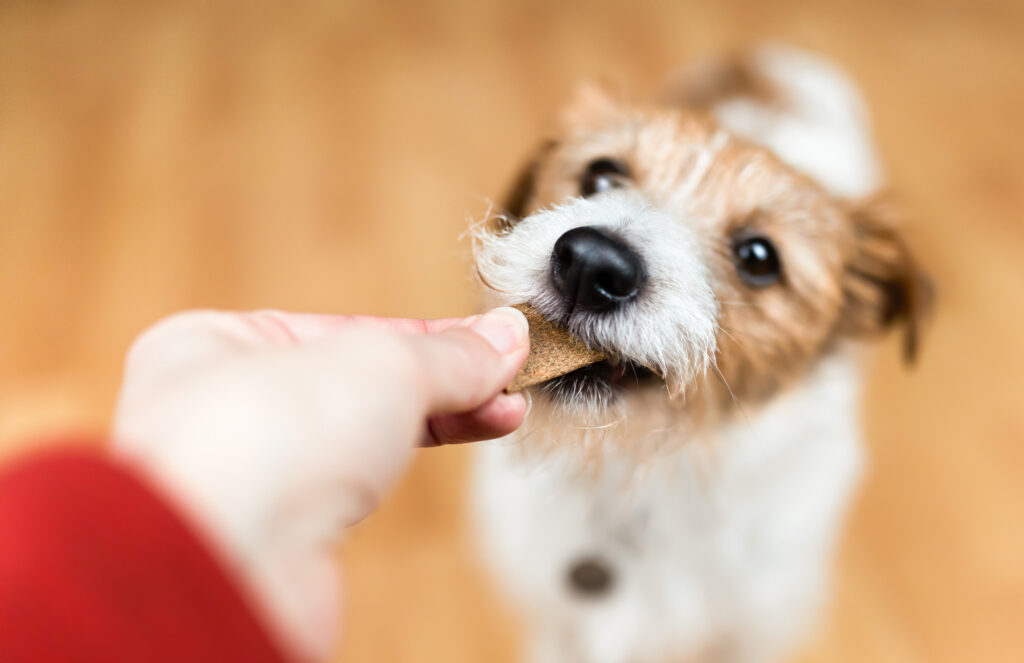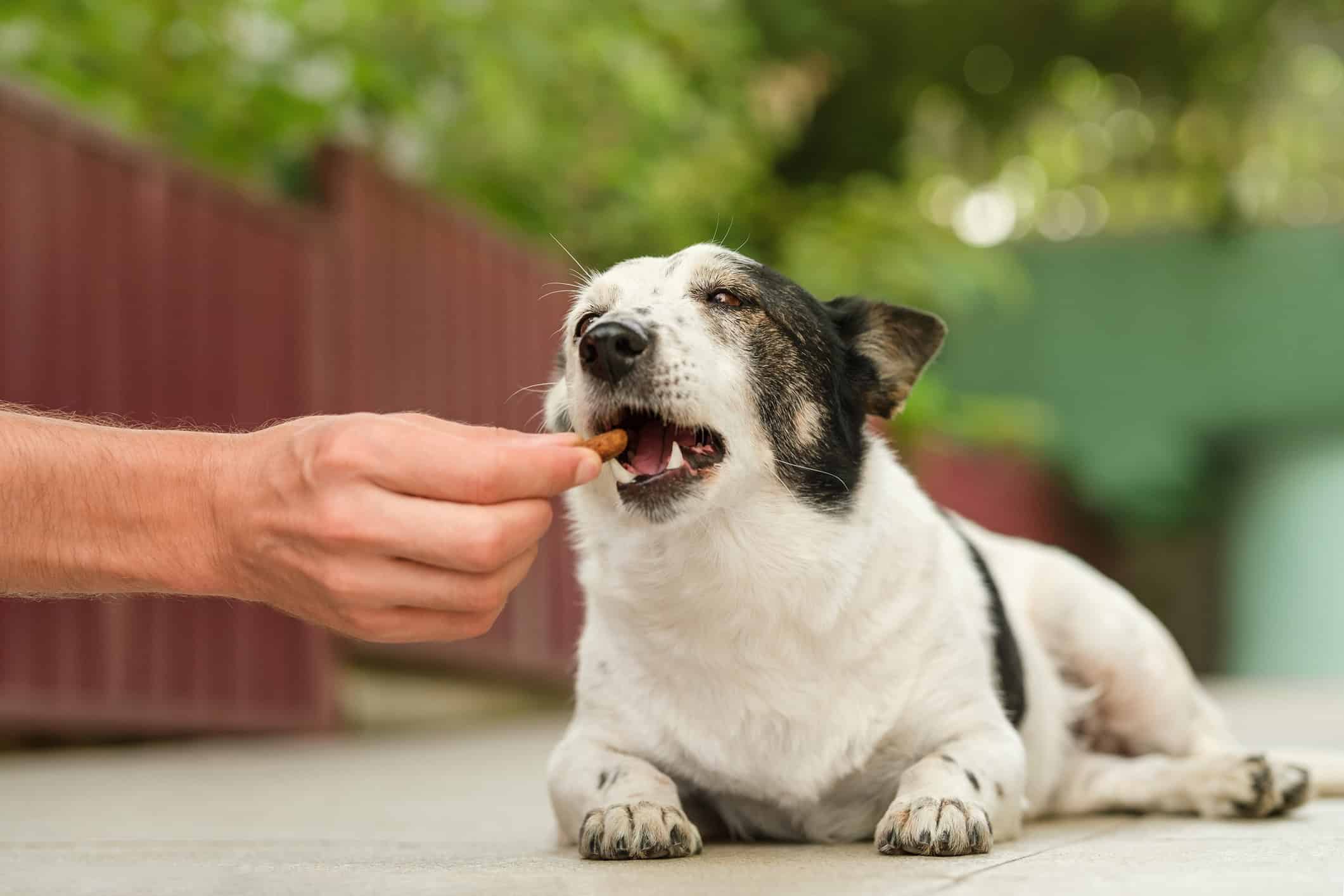When it comes to dog training, motivating your dog to perform new behaviors is imperative. Using an incentive is a great way to encourage them to learn and maintain obedience commands, or to correct unwanted or undesirable behaviors.
Dog training treats are one of the most common ways to build up this motivation in your dog, but dispensing an endless supply of treats can have other consequences.
In this article, we’ll look at how many training treats your dog should be consuming, and the factors to consider.
How many treats per day should your dog consume?
If you’re working out how many treats your dog should eat each day, it is important to consider their diet as a whole. Your dog may eat anywhere from two to four meals each day, and you may supplement this with treats or other food.
It isn’t the actual number of treats that matters, but the calorie intake of those treats when taken as a whole with the rest of their food. With this in mind, many veterinarians and canine nutritionists recommend following the ten percent rule.
What is the ten percent rule?
The ten percent rule states that no more than ten percent of your dog’s calories should be derived from treats.
As an example, if your dog needs an average of 1,000 calories per day to maintain a healthy weight, you should feed them no more than 100 of those calories in the form of treats.
If you’re unclear how many calories your dog should be consuming each day, be sure to check with your veterinarian.
Counting calories throughout the day
Taking the ten percent rule into account, it is therefore essential to understand your dog’s calorie intake throughout the day. This can enable you to plan training sessions – and the treats involved in those sessions – accordingly. It can also help you to slightly reduce their food intake at meal times if necessary.
The manufacturer of your dog food will typically print calories and other nutritional information on the outside of their bag. You will need to calculate how many calories your dog consumes from each meal, and then adjust it down by ten percent to allow space in their food plan for training treats.
If you feed your dog a raw (or partial raw) diet, make sure to check with your supplier for accurate calorie estimates.

Factors that influence the amount your dog eats
There are a number of factors that can influence the calories that your dog should consume each day. These include:
- Size – It stands to reason that larger dogs will need to consume more calories than smaller dogs to help their bones and muscles develop adequately.
- Age – In the early months of their development, puppies need a surprising amount of food – sometimes up to twice as much per pound as an adult dog. On the contrary, senior dogs – with lower activity levels and slower metabolism – require fewer calories.
- Breed – Some dog breeds were bred specifically for high-activity work – such as farm dogs or other working dogs. These dogs will always need a greater amount of nutritional intake, purely on the basis that they will burn a lot of it off in the course of their working activities.
- Activity level – If you have a particularly active or energetic breed who needs constant physical exercise, they will need fuel for these activities. Increasing their food intake is the most obvious way to supply them with the extra energy they will need.
- Medical/special dietary requirements – If your dog has special medical or dietary requirements that have been identified by your veterinarian, you may need to adjust their food intake accordingly.
How to choose dog treats
There are three major questions to answer when considering your options for training treats.
- Which treats will motivate my dog?
- What is the nutritional value of these training treats?
- What is safe for my dog to consume?
Motivation matters when it comes to teaching your dog new behaviors. Using your dog’s regular food for training treats isn’t recommended, because your dog knows they’ll be getting another helping of that soon enough. Therefore, finding a treat that is a high-value reward for your dog is of vital importance to successful training outcomes.
If you head to your local big-box pet store, there are entire aisles devoted to dog training treats. Some of these treats may vary in quality, and can also be expensive for what you actually get. Make sure you study the ingredients and nutritional value of these treats before purchasing them.
Perhaps the quality and price of commercial dog treats has deterred you, and you’re considering making your own treats, or using high-value food items from your refrigerator. Cheese is often used as a ‘homemade’ treat for dogs, but remember that cheese can be very calorie-dense. Suitable alternatives may be white-meat poultry or vegetables. It goes without saying to check before feeding anything to your dog that it is safe for them to eat.
Consult with your veterinarian if you have questions or need recommendations about the treats that would be most suitable for your dog.
Why this matters
When we speak with our clients about the philosophy behind how dogs learn, we often talk about the value of rewards. Finding those rewards that motivate our dogs to perform certain behaviors can often take some trial and error until we find the item that persuades them to work.
However, having found that motivator, we also have to balance that against other factors that affect their health, including obesity. Having an obedient, well-trained dog is great – but it shouldn’t result in health problems that can be caused by a poor diet. Our dogs are relying on us for a number of things, including portion control – and dispensing the right amount of treats is crucial to maintaining their overall health.
Related posts

Train Your Dog To Lie Down [Step-by-Step]
Teaching your dog to lie down is a simple way to bring some control to chaotic situations.

How Many Training Sessions Does A Dog Need?
There are several factors that can influence how many training sessions your dog might need – find out about them in this article.

How To Help A Timid And Shy Dog
If you suspect your dog is shy or timid, this article is designed to help you identify the signs and build their confidence.


You must be logged in to post a comment.